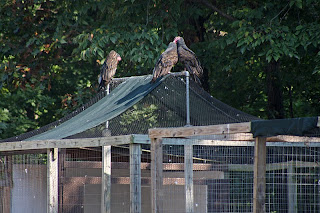Charlie, our Thick-billed Parrot, spends part of her time in our Nature Center greeting guests when they enter.
Charlie came to World Bird Sanctuary in 2007 from Kaytee Products, Inc. in Chilton, WI. She was originally rescued by the U.S. Fish and Wildlife Service from a facility where she and three other Thick-billed Parrots were being held illegally. They were given to Kaytee for safekeeping.
Charlie and her friends were transferred to World Bird Sanctuary to join the free flying flock of Thick-billed Parrots housed in the large enclosure on our display line. We chose to keep Charlie for education since she was already trained to step to trainers and mimicked a few words.
Charlie greets the staff at the Nature Center with quite an adorable foot wave, and uses the wave “shamelessly” to get treats. Thick-billed Parrots are not known as being great mimickers, but Charlie says “Hi” very clearly. She also makes a kissing sound.
It's hard to resist Charlie's "wave"
Charlie seems to enjoy hanging by her beak on the sides of the cage until she gets attention; which generally comes from the members of the public that come up to the staff to tell us we have a bird that is stuck. She is not stuck--just trying to get more attention. All of our Thick-billed Parrots do this behavior, even the breeding flock. We do not know how or why this behavior originated, but it certainly works to Charlie’s advantage, since it gets her the attention she likes. This is an excellent example of how an intelligent animal like a parrot can train its human caregivers.
The Thick-billed Parrot is the only remaining parrot native to the United States. They weigh in at 11-13 ounces, are 15-17 inches long and can live 35-40 years. They were once found in Arizona and New Mexico, but are now only found in a small part of Mexico. The Thick-billed Parrot lives at high elevations in the pine forests year round. They have been given the nickname of Snow Parrot because they tolerate cold temperatures and snow. In the wild Thick-billed Parrots eat primarily pine seeds, acorns, juniper berries, conifer buds, agave nectar and insect larvae.
The Thick-billed Parrot is an Endangered Species with only 500-2,000 individuals left in the wild. The main threat to the Thick-billed Parrot is habitat loss. With forests being destroyed Thick-bills have fewer nesting sites. Biologists are trying to work with local landowners to protect these forests. They are also trying to use nest boxes to provide nesting sites for these birds. Currently these efforts are helping to keep the population stable but not increasing. The second threat to the Thick-bill is just humans. Thick-bills are very flock oriented and when one bird goes to the ground and gets caught in a trap, they all go to the ground, putting the entire flock in danger.
Like most of the world’s parrots, the Thick-billed Parrot is a very social parrot living in flocks all the time. Their call can be heard up to 2 miles away. They also have a call that can sound like children laughing. To read more about this rare species and the part it plays at the World Bird Sanctuary Click Here.
Charlie,,as well as all of our other birds, is available for adoption. To adopt Charlie click here to go to the Parrots Adopt A Bird page on our website, click on Charlie’s photo, then click Add to Cart and follow the directions for payment. Adoption donations are tax deductible to the full extent of the law.
Your adoption donation will help to feed, house and keep this adorable little character waving for her treats.
Adopt-a-Bird Parents receive:
· A personal visit with the animal you adopt!!!! Call ahead to schedule a time for your personal visit.
· Certificate of Adoption.
· Color photo of the animals you’ve adopted.
· Sponsorship card.
· One year’s subscription to Mews News, WBS’s quarterly newsletter.
· Life history and natural history of the animal.
· 10% discount off WBS merchandise.
Adoption Donation for Charlie - $100.00
Submitted by Cathy Spahn, World Bird Sanctuary Field Studies Coordinator




















































